Similar Posts
A little while ago an iconographer wrote me to ask advice on what shape he should make the well in an icon of the Samaritan Woman, who is known in tradition as St-Photini. After answering him, I realized that this detail in the icon is a good example of how so much can be hidden in so little, of how the icon can hold within itself layers and layers of meaning and can even act as elucidation of Biblical passages.
The story of the Samaritan woman at the well is one I have been pondering for many years. It is related to the questions of periphery, the foreigner and death which I have discussed in many articles, mostly my series on St-Christopher. It also happens to be one of the oldest images of Christianity, found in the catacombs.
The story is well known and appears in the Gospel of St-John ch.4. In the way it is presented, it refers to many Old Testament passages, and especially those that show someone finding his wife at a well. Rebecca the wife of Isaac, Rachel the wife of Jacob and Zipporah the wife of Moses (1) were all encountered in this manner. Many church fathers saw this mystery, for example Saint-Caesarius of Arles tells us that
“Since all three of those patriarchs (Isaac, Jacob, Moses) typified our Lord and Savior, for this reason they found their wives at fountains or wells, because Christ was to find His Church at the waters of Baptism” (2)
And so the scene between Christ and the Samartian is told in a manner that suggests Christ is “finding a wife” (not in a carnal union but a spiritual one). In this manner St-Photini is an image of the Bride of Christ, the Church itself in some of its aspects. We should therefore not be surprised that although the earliest versions of the well in her icon were round, we then will see appear versions where the well is in the shape of a cross, representing the form of many ancient baptismal fonts. This is the case in the fresco of the Samartian Woman by Panselinos . Of course baptismal fonts have many shapes, round, oval or even octagons, but the cross shape unites the symbolism of the well to the symbolism of the source or the fountain as it refers to the four rivers of paradise going in each direction (3).
The Samaritan woman is an image of the Bride, but this Bride is not just any woman, she is a “heretic”. Samaritans were descendants of the northern tribes of Israel who had mingled with foreign pagans and created a syncretism with other religions and local gods. In that sense the Samaritan woman is a version of the “foreign woman”. The early Israelite are constantly proscribed from joining themselves to foreign women, seen as leading to “prostituting oneself” to the foreign gods these women serve (4). Because of the general warning about foreign women, in the structure of the Samaritan’s story we see not only an allusion to the finding of a bride at a well, but also an allusion to Proverbs 5 where King Solomon warns us about the foreign/loose woman.
For the lips of a strange woman drop as an honeycomb, and her mouth is smoother than oil:
But her end is bitter as wormwood, sharp as a twoedged sword.
Her feet go down to death; her steps take hold on hell.
…
Remove thy way far from her, and come not nigh the door of her house:
Lest thou give thine honour unto others, and thy years unto the cruel:
Lest strangers be filled with thy wealth; and thy labours be in the house of a stranger;
…
Drink waters out of thine own cistern, and running waters out of thine own well.
Let thy fountains be dispersed abroad, and rivers of waters in the streets.
Let them be only thine own, and not strangers’ with thee.
Let thy fountain be blessed: and rejoice with the wife of thy youth.
The symbolism is complex in this text because the word for “strange woman” has also the sense of “another woman” and so the text joins the notion of what is foreign/strange with adultery or fornication. In the text of Proverbs this foreign/loose woman is associated with death, her end is bitter, her feet take hold on hell. The “bitter waters” refer to the primordial chaos of creation, and in a Biblical and Orthodox vision, these bitter waters are not compatible to sacred use, they are an image of death, the waters of chaos, they must be “sweetened” by the tree (5). In the lower waters hide monsters and dragons and foreign gods as we see in the icon of Theophany. We need only look at the prayer of exorcism said by the priest over the waters of the baptismal font to be convinced:
You hallowed the streams of Jordan, sending down from the Heavens Your Holy Spirit, and crushed the heads of dragons that lurked therein. Do yourself, O loving King, be present now also through the descent of your Holy Spirit and hallow this water.
This image of the Holy Spirit descending on the water, which we find in the prayer, but which we also see in the story of Christ’s Baptism when the dove descends, is a vision of a new creation. It reproduces the very first cosmological representation at the beginning of the world in Genesis. “The Earth was chaos and void and the Spirit of God was above the waters”. But now in the person of Christ (the Word) we find a “bridge” which connects the Spirit and the Waters, now we have one who’s feet, like the foreign woman also “take a hold of hell”, but who’s head reaches the highest heavens. (6)
Returning to the Samaritan we see that just like the strange woman of Proverbs 5, she is also a combination of a foreign and a loose woman. She is the foreigner who does not even expect a Jew to talk to her, but she also shows her own moral chaos for also having had five husbands and now living with a man with whom she is not married. And so here it would seem Christ is doing exactly what the Proverb is warning us not to do: as she is offering him of her well, he answers by offering her his own fountain of living water. But herein lies the mystery, for Christ is the only one who can “marry the foreign woman” without being ensnared by her, indeed rather leading her to salvation (7).
The story of the Samaritan woman is therefore related to baptism and her well becomes an image of the baptismal font, full of the bitter waters of death which will be sweetened by Christ. The very person of St-Photini, the Samaritan woman is somehow bound up with the well itself. In her later story of martyrdom found in tradition, she is kept prisoner in a well and is finally martyred by being thrown down into a well (8).
So when we see the well in the icons of the meeting of Christ and St-Photini as being round or cross shaped we intuitively relate it to the baptismal font. But there is another tradition, one which portrays the well as being a hexagon.
Although to some this might seem arbitrary, this tradition of the hexagon points to a more hidden aspect of the story of the Samaritan. The hexagon is a six-sided figure and in the story of the Samaritan there are two very prominent references to the number six (9). First of all the story happens at the “sixth hour” a detail worth mentioning as it is sometimes translated as “noon” using our modern way of counting the day from midnight and midday rather than from the setting and rising of the sun. The other reference to the number six happens in the recounting of the Samaritan’s life. She has been with five husbands and the sixth man she is currently with is an illegitimate relationship. Christ finally appears as her seventh and final husband, her Sabbath, her rest. And in this manner the well becomes even more closely an image of the Samaritan herself, but it is also a more general symbol of man (who was created on the sixth day) and of all of creation itself, the “hexaemeron”. But the sixth day is also Holy Friday, and so in this sense the number six unites the notion of Man as the pinnacle of creation, but also the fall/death of Man and his redemption through the death of Christ. It is a very powerful image which implicitly shows the very paradox contained in the story of salvation. It is mysterious indeed for in the story of the Samaritan the symbolism of six is shown as both ascending and descending, for at the sixth hour the sun is the highest in the sky, symbolically at the zenith, whereas the Samaritan woman having had five husbands, an already sad descent, now finds herself at her lowest point, her nadir, as her sixth relationship is an adulterous one. She is if you will “at the bottom of her well”10.
In conclusion, the different shapes of the well in the icon of the Samaritan show how several traditions of representation can often coexist in iconography so to emphasize different aspects. We can also see how small details both in icons and in stories, details which might seem arbitrary at first sight, can reveal many layers of truth.
After the explanations, our iconographer pondering the shape of the well in his icon of the Samaritan woman decided to use the hexagon. Good choice.
————————————————
1. It is also important to notice that the wife of Moses is an “Ethiopian” and so a foreigner par excellence.
2. Saint-Caesaria of Arles quoted in “Sermons, Volume 2 (81-186)” (The Fathers of the Church, Volume 47), CUA Press, 2010, pages 34-35.
3. See my article “Heaven is Round, Earth is Square” and also Andrew Gould’s article “Gardens, Churchyards, and Cemeteries”.
4. See for example Exodus 34:12-16.
5. Sweetening the waters by the tree happens in the Exodus 15 where Moses put a tree in bitter waters to make them drinkable. We refer to this event in the ritual of blessing of the waters at Theophany, where the cross is dipped in water to bless it, joining the old testament story with the baptism of Christ.
6. These types of images can help us understand the appearances of feet, of washing feet in the New Testament as being related to the question of a transformation of death in the story of the woman who washes Christ’s feet with her hair, but also Christ washing the feet of the Apostles. For hair as an image of death, see st-Gregory of Nyssa Gregory of Nyssa, Life of Moses, II, 101.
7. There are also very technical hints in the story of the Samaritan regarding this. For example, the well in question in the story is Jacob(Israel)’s well, but it is also on the land that Jacob gave to his son Joseph. Joseph is the one who traveled to Egypt (as the Christ child), traveled into death (the bottom of a well, prison, famine, etc) to bring salvation. Joseph, like Moses also took a foreign wife. For Egyptians as image of the garments of skin and death, see st-Gregory of Nyssa’s comment on Moses killing the Egyptian as an image of Baptism. Gregory of Nyssa, The Life of Moses, II, 289.
8. See a version of her story here: http://www.antiochian.org/st-photini-samaritan-woman
9. Blessed Augustine speaks of the number 6 in his City of God (book XI, chap.30) as being a perfect number because it is made by adding the first three numbers which also divide it, for 6 can be divided by 1, 2 and 3, and 1 + 2 + 3 = 6 (You can also do it with multiplication: 1 x 2 x 3= 6).
10. One could think of this structure not only as a hexagon but a hexagram, which is the six pointed star, “star of David” and shows the union of the masculine and feminine with a triangle pointing up (Christ, the sun) and a triangle pointing down (The Samaritan Woman, the well).

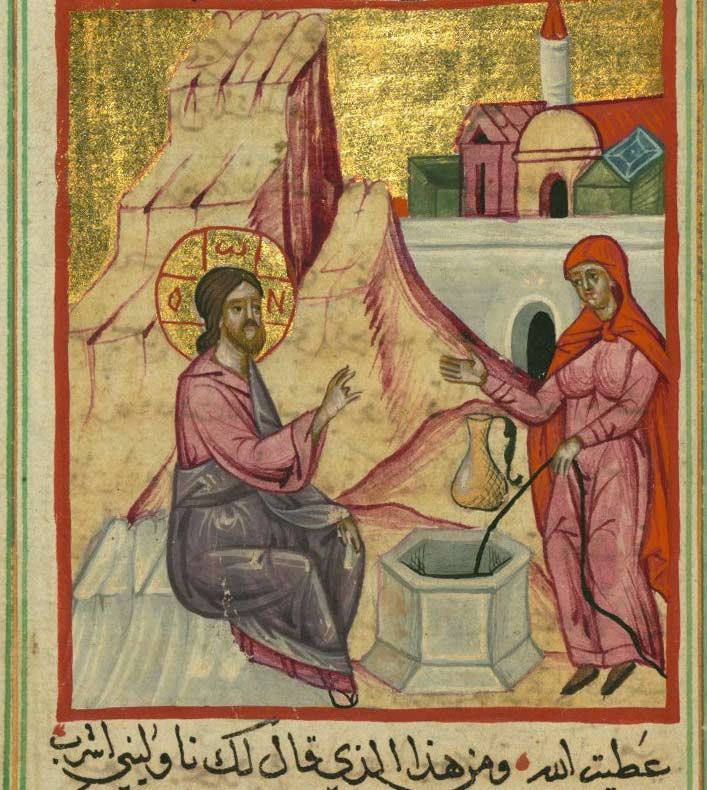
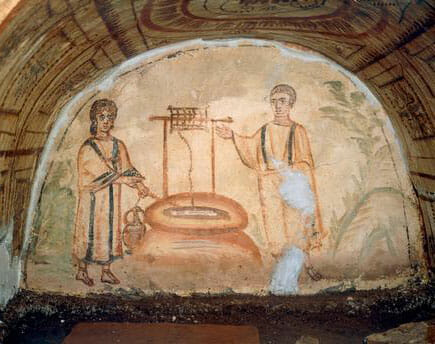
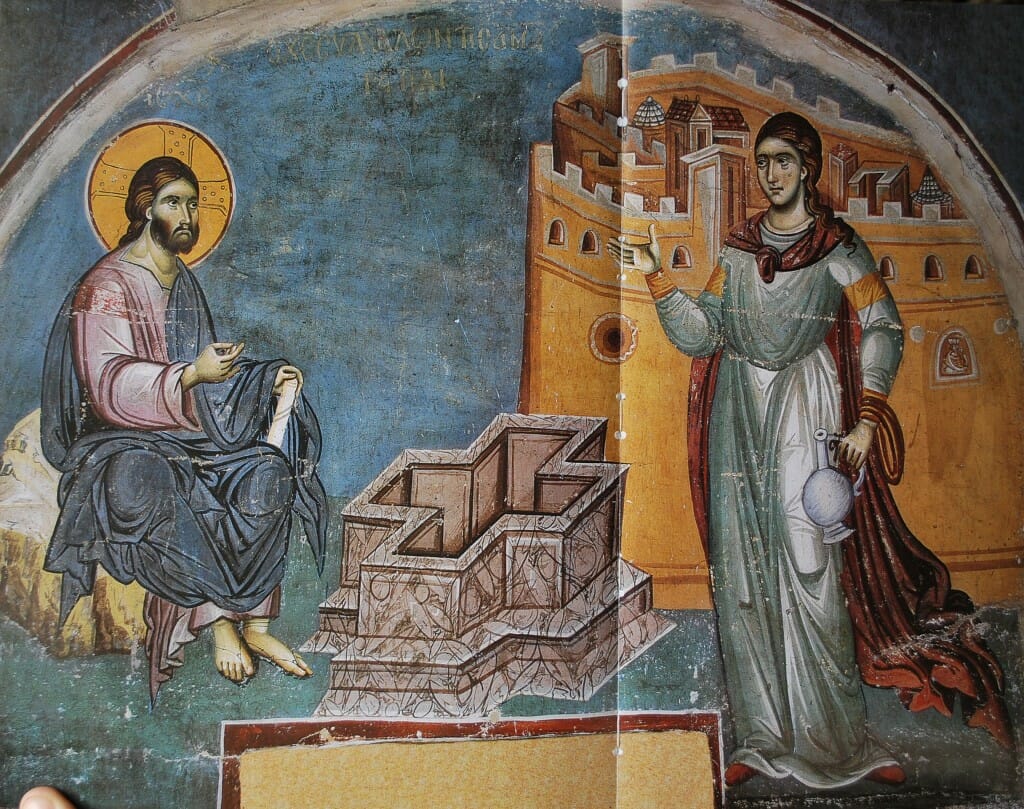
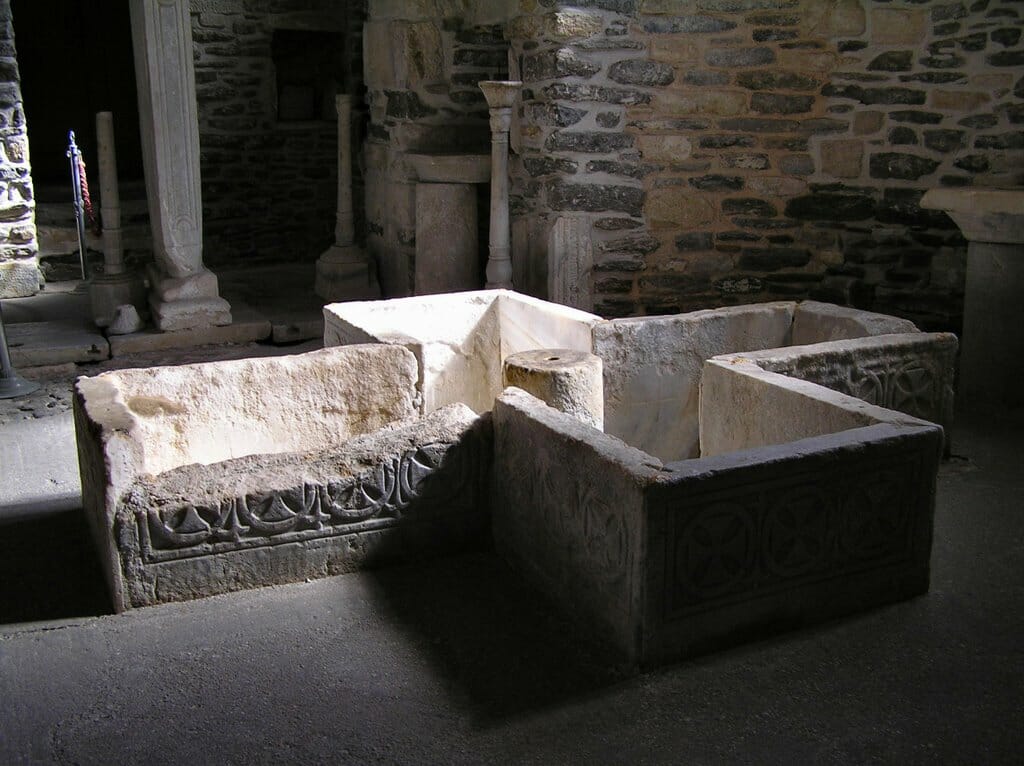
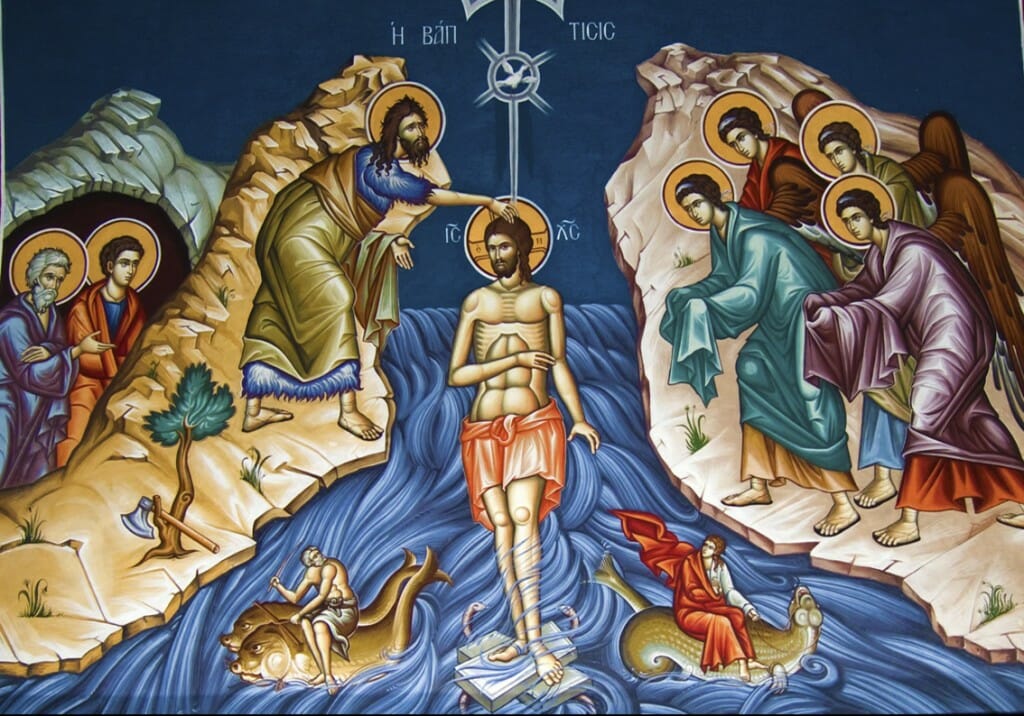
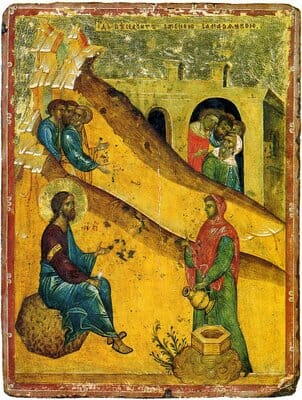
This is so fascinating! I will re-read this many times. Photini is my patron saint and I am just awe-struck with the wealth of symbolism and truth in this story. Thank you very much for this in-depth piece.
I am happy you could find some aspects of the story that you can ponder. We are often so used to Biblical stories that we often take them for granted and fail to see how profound and intricate they are behind their simplicity.
I had read somewhere that the two men in the river in the Theophany icon represented the Jordan and the Red Sea, corresponding to the psalm verse: ‘What ailed thee, O thou sea, that thou fleddest? thou Jordan, that thou wast driven back?’
Yes, you are of course right, but they are represented using the ancient iconology of minor river and see gods, riding sea monsters and carrying vases, sometimes staffs, see for example this ancient representation: http://www.maicar.com/GML/000Images/qrim/rivergods3405.jpg Some people do not want to represent these little creatures in the Theophany icon and in later icons you sometimes see them disappear, though hopefully in the context of what I have explained, it makes sense to represent the “waters” with ancient gods.
Amazing. Are there other places in art you know of where the number six represents creation, or humanity? And what can you say about the devil’s number 666? Does this signify a created trinity of Satan, antichrist, and unholy spirit – in contrast to the uncreated Holy Trinity?
Well, St-Basil’s commentary on Genesis is called the “Hexaemeron”, the six days. Often the hexagram is called the “star of creation” in Christianity though I don’t know the origin of this. As for the number 666, it is a very mysterious thing indeed. Just as 6 is a perfect number, 666 is also a perfect number in many ways. Just as saint-Augustine showed that 1+2+3=6, well if you add 1 through 36 (6×6=36) in the same manner, then you get 666 . There is a 6 x 6 “magic square” in which each row and column adds up to 111 and so comes to 666. In the Bible there is another place where 666 appears and it has to do with gold, it is the number of talents of gold taken in by Solomon every year. 666 in revelations has something to do with money as well. According to st-Irenaeus 666 is related to Rome. My opinion is that 666 has something to do with an excess of perfection, or an excess of self-sufficiency, of control where someone or some system believes itself to be “perfect”. So 666 is not so much the “number of a man” rather than the “number of man” in the manner in which man reached on his own to be the equivalent to God in the Garden. That is a sin of the right hand, a sin of excess of perfection. Of course it is also the sin of the Evil One and so it is the root of all blaspheming. So in our context, we could easily see modern civilization’s excess of perfection and control bringing arrogance and self-sufficiency and causing humans to reject God and blaspheme him. Of course these are just intuitions and thoughts, I’m pretty sure the full mystery of 666 will only be revealed in the end.
This was a really great article! I like to use icons in our Sunday school lessons, so the next time we discuss baptism or the Samaritan Woman we will also have the well to spur conversation.